
* Britain fielded a range of different bombers during World War II, these aircraft meeting with different levels of success. One of the most successful was the Vickers "Wellington", a twin-engine medium bomber that was built in great numbers, and adapted to many different roles. This document provides a history and description of the Wellington -- as well as its "Wellesley" predecessor; its enlarged "Warwick" sibling; and its "Viking" transport descendant.
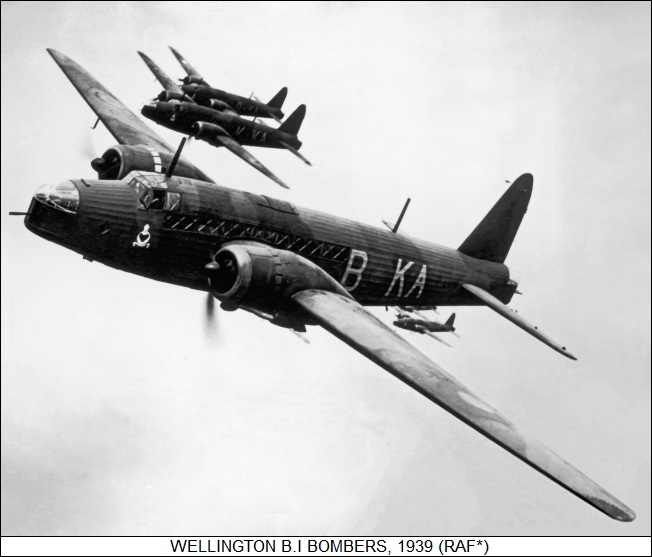
* The British Vickers aircraft company -- which had rather complicated organizational origins not worth discussing here -- developed the Vickers Vimy biplane heavy bomber late in World War I, with the company developing improved biplane bomber designs after the conflict. In 1927, Vickers became "Vickers-Armstrong" through a merger, though the "Vickers" name is just used here for simplicity; the new firm was a military powerhouse, retaining a major interest in advanced aircraft development.
In the 1930s, the British Air Ministry issued a requirement designated "G.4/31" for the Royal Air Force (RAF), specifying what might be now called a light "multirole" aircraft, capable of bombing, attack, reconnaissance, and air ambulance roles. Most British aircraft design firms responded to G.4/31, with Vickers offering the "Type 253" -- another biplane design, the major innovation being a latticework "geodetic" airframe construction, originally devised by the brilliant engineer Barnes Wallis for the ill-fated R100 airship. The Type 253 won the competition, with 150 ordered.
As it turned out, only one Type 253 was ever built. Vickers, leveraging off design engineering concepts used for the Type 253, came up with a similar but more advanced monoplane bomber design, the "Type 246", using company funding, the Type 246 prototype performing its initial flight on 19 June 1935. The Air Ministry had already amended the Type 253 order to substitute the Type 246, with a new specification, "G.22/35", written to cover. A total of 176 production machines, with the service designation of "Wellesley Mark I", were built, being delivered to the RAF in 1937 and 1938.
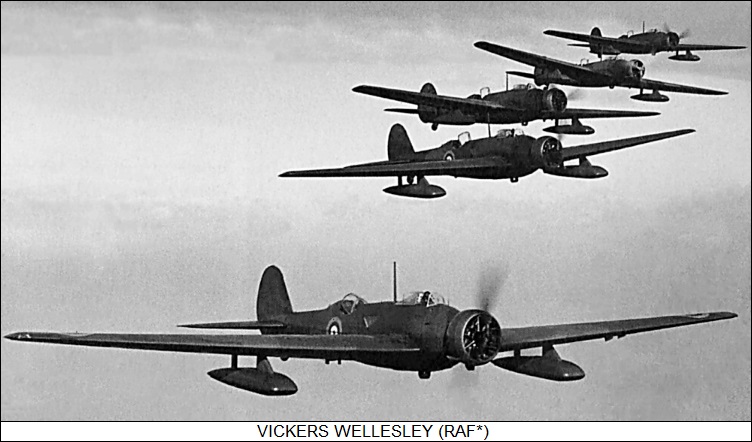
* The Wellesley was likely a futuristic-looking machine when it was introduced, and indeed it retains a certain sci-fi "retropunk" look in the 21st century. It had twin cockpits, one forward and one aft, connected by a cabin with windows on each side. It was powered by a Bristol Pegasus XX air-cooled nine-cylinder radial engine providing 690 kW (925 HP), driving a de Havilland-Hamilton three-bladed variable-pitch propeller. It had taildragger landing gear, the tailwheel being fixed, the single-wheel main gear pivoting from the wings towards the fuselage.
___________________________________________________________________
VICKERS WELLESLEY MARK I:
___________________________________________________________________
wingspan:
22.73 meters (74 feet 7 inches)
wing area:
58.5 sq_meters (630 sq_feet)
length:
11.96 meters (39 feet 3 inches)
height:
4.67 meters (14 feet 4 inches)
empty weight:
3,065 kilograms (6,760 pounds)
MTO weight:
5,670 kilograms (11,050 pounds)
max speed at altitude:
370 KPH (230 MPH / 200 KT)
cruise speed:
290 KPH (180 MPH / 155 KT)
service ceiling:
7,770 meters (25,500 feet)
range:
1,965 kilometers (1,220 MI / 1,060 NMI)
___________________________________________________________________
The geodetic fuselage design consisted of a matrix of light alloy metal segments, fitted together with rivets and joints into a "basket weave". The result was complicated to build -- but was light and strong, allowing fit of graceful wide-span wings, the wings also featuring geodetic construction. A single 7.7-millimeter (0.303-caliber) Vickers machine gun was fitted in the right wing, with another on a flexible mount in the rear cockpit. In order to maintain the integrity of the fuselage, the Wellesley didn't have a bomb bay, munitions instead being carried in a pannier under each wing, total bombload being 900 kilograms (2,000 pounds).
A few Wellesley Mark Is -- it's unclear how many -- were for whatever reason fitted with an extended "greenhouse" canopy behind the forward canopy; these machines have been described with the designation of "Wellesley Mark II", though apparently that was informal. Five Mark Is were modified for long-range flights with an autopilot; provision for three crew, to allow a pilot to get some rest; a Pegasus Mark XXII engine with 755 kW (1,010 HP), driving a three-bladed Rotol (Rolls-Bristol) variable-pitch propeller; no guns or underwing panniers; and additional fuel tanks.
In November 1938, two of these long-range machines under the command of Squadron Leader Richard Kellett flew from Ismailia, Egypt, to Darwin, Australia, establishing a non-stop flight distance record of 11,525 kilometers (7,162 miles) in about 48 hours, handily topping a record set by Soviet fliers in July. The British long-range record was not broken until just after the end of World War II. There had actually been three aircraft in that flight, but one had to set down in East Timor.
Aircraft design was moving rapidly in the 1930s, and by the outbreak of World War II in September 1939, the Wellesley had been retired from first-line use in Britain -- though it did fight in Africa, performing attacks on Italian forces in East Africa during the British campaign there in 1940 and 1941. It performed maritime patrol from Egypt into 1942, carrying four 115-kilogram (250-pound) depth charges, then being finally retired in favor of more modern aircraft. The last Wellesleys were struck off charge in 1944.
BACK_TO_TOP* The Wellesley was effectively a technology practice exercise for a better bomber -- Vickers having moved on to a more formidable aircraft design in response to Air Ministry Specification "B.9/32" of 1932, which stipulated a twin-engine bomber with a range of 1,160 kilometers (720 miles) and a bombload of 450 kilograms (1,000 pounds). Vickers came back with a proposal with about four times that range and bombload, so not surprisingly the Air Ministry ordered a prototype.
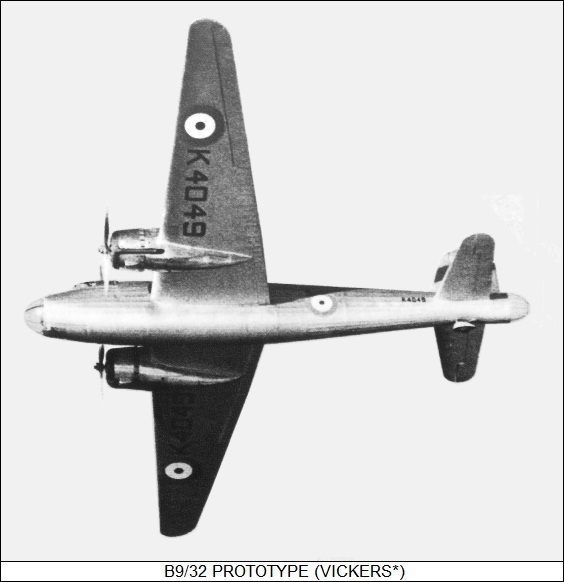
The B.9/32 prototype, the Vickers "Type 271", took to the air for the first time on 15 June 1936, the pilot being Joseph "Mutt" Summers. It was a midwing monoplane with twin Bristol Pegasus X radial engines, providing 680 kW (915 HP) each and driving three-bladed variable-pitch props; retractable taildragger landing gear; and a fabric-covered geodesic airframe. The prototype was unarmed, though it was designed to have a single machine gun on a flexible mount in nose, tail, and dorsal positions. The prototype crashed after a flight structural failure on 19 April 1937, the pilot being thrown out and parachuting to safety, the flight engineer being killed.
Trials were nearly complete by that time, the aircraft having clearly demonstrated its merits. In fact, the Air Ministry had been so impressed that it had cut another requirement, Specification "B.29/36", to cover a production version, along with an initial order for a batch of "Wellington" bombers -- named after Wellington, New Zealand, RAF bombers being named after towns, but of course echoing the 1st Duke of Wellington, who had defeated Napoleon. The name "Crecy", after the great English victory over the French in 1346, had been applied earlier, but was dropped. The production machine featured substantial changes from the initial prototype, most notably a deeper fuselage and revised defensive armament -- including twin-gun Vickers nose and tail turrets, plus a retractable belly "dustbin" turret, also with two guns.
A preproduction prototype of the "Wellington Bomber Mark I (B.I)" performed its initial flight on 23 December 1937, being powered by Bristol Pegasus X engines. Most production B.Is were fitted with Pegasus XVIII radials providing 785 kW (1,050 HP) each; 178 B.Is were built by the main factory at Weybridge, plus 3 at the shadow factory at Chester, for a total of 181.
The Vickers turrets proving unsatisfactory, Fraser-Nash nose and tail turrets were installed in their place, the result being the "Wellington Bomber Mark IA", with 187 built at Weybridge (170) and Chester (17). RAF crews named the type the "Wimpey", after the hamburger-loving sidekick of Popeye the Sailor, J. Wellington Wimpey: "I will gladly pay you Tuesday for a hamburger today." All B.IAs served with the RAF; 30 were to go to the Royal New Zealand Air Force, but they were diverted to the RAF when war with the German Reich broke out in September 1939.
* From the outset, the Wellington was in the thick of the fighting, performing unescorted daylight raids, primarily against German ports. The very first RAF bombing attack of the war was performed on 4 September 1939 by Wellingtons and Bristol Blenheims, in an attack on shipping at Brunsbuettel; two Wellingtons went down, the first RAF aircraft lost in the conflict.
RAF Bomber Command believed that daylight bombing operations could be carried out with acceptable losses if bombers maintained a tight formation and concentrated their defensive fire; they were partly being deceived in this belief by weak response from the German Luftwaffe, the defenders being confounded by poor coordination and bad weather. The Germans were always quick to deal with their shortcomings, however, and losses of Wellingtons mounted. The culmination of this process occurred on 18 December, when 24 Wellingtons attacked German naval targets at Heligoland Bight. The Luftwaffe had come up to stride on the defense, the result being that half the force was lost, and a fair number of the Wellingtons that made it back to Britain were not in any condition to ever fly again.
Combat experience showed the dustbin belly turret was useless, and that the Wellington was vulnerable to attacks from the sides. The assumption in prewar days was that contemporary aircraft were too fast to make intercepts from the sides practical. That having been proven unpleasantly wrong, the dustbin was dropped and a single 7.7-millimeter machine gun was fitted on a flexible mount on each side. The geodesic airframe was convenient for altering window configurations, since all that had to be done was fit different cells in the airframe with transparencies -- and in fact, the variation in window fit between Wellington variants is very confusing.
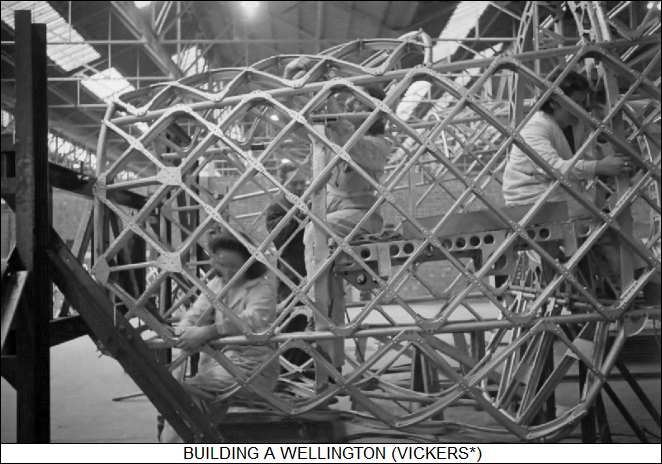
This new weapons fit was apparently evaluated on a B.IA, being given the designation of "Wellington Bomber Mark IB" for the exercise -- though sources are obscure on this point, the B.IB possibly having been a discarded concept. In any case, no B.IB bombers were ever rolled out of the factory.
As a result, the Wellington B.IA was followed by the "Wellington Bomber IC", with 2,685 built into 1942 by the main factory at Weybridge (1,052), plus the shadow factories at Chester (1,583), and Blackpool (50). It had the updated armament fit, larger main gear wheels, plus better electrical and hydraulic systems. With refinements in production techniques, the complexity of the geodetic airframe became much less of an obstacle to manufacture.
___________________________________________________________________
VICKERS WELLINGTON B.IC:
___________________________________________________________________
wingspan:
26.27 meters (86 feet 2 inches)
wing area:
78.1 sq_meters (840 sq_feet)
length:
19.69 meters (64 feet 7 inches)
height:
5.31 meters (17 feet 5 inches)
empty weight:
8,435 kilograms (18,556 pounds)
MTO weight:
12,955 kilograms (28,500 pounds)
max speed at altitude:
380 KPH (235 MPH / 205 KT)
service ceiling:
5,490 meters (18,000 feet)
range:
4,105 kilometers (2,550 MI / 2,215 NMI)
___________________________________________________________________
Unescorted daylight raids having led to defeat, Bomber Command switched to night bombings, with Wellingtons participating in the first night raid on Berlin, on 25 August 1940. RAF night raids were absurdly inaccurate at first, dropping bombs almost at random, amounting to no more than a nuisance to the Germans. The failure of RAF tactics was not seen as a failure of the Wellington, however; while its defensive armament proved inadequate and its lack of self-sealing fuel tanks was a deadly defect, both those problems could be addressed, and it had demonstrated an ability to soak up a great deal of damage. It had a capacious bomb bay as well, able to accommodate 900-kilogram (2,000-pound) bombs, and from the spring of 1941, a 1,800-kilogram (4,000-pound) bomb. 183 B.IC were delivered with a rack under each inner wing for a torpedo, trials having shown the Wellington was suitable for the torpedo-bomber role.
BACK_TO_TOP* The "Wellington Bomber Mark II" was introduced in October 1940, the primary change being replacement of the Pegasus XVIII engines with Rolls-Royce Merlin X water-cooled vee-16 engines, providing 855 kW (1,145 HP), instead of radials. It also had a larger tailplane, and beefed-up landing gear. An initial prototype, the "Type 298", had been flown before the outbreak of war. 401 B.Is were built, all at Weybridge.
The B.II had improved performance, if somewhat shorter range and lower bombload, due to increased engine weight. For whatever reasons -- possibly engine availability -- the B.II was the only Wellington full-production variant with Merlin engines. The prototype of the B.II was used for trials with an oversized dorsal turret with a 40-millimeter Vickers cannon; it was eventually fitted with twin tailfins, to deal with lateral stability problems. Another B.II was experimentally fitted with a 40-millimeter cannon in the nose.
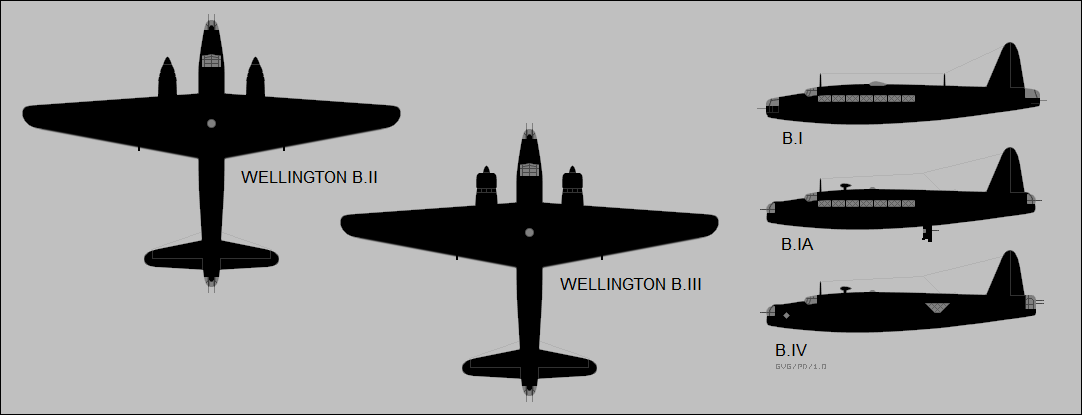
* Following trials fit of Bristol Hercules III radials, with 1,065 kW (1,425 HP) each, on a B.IC, production moved on to the "Wellington Bomber Mark III", with Hercules XI radials, providing 1,185 kW (1,590 HP) each. The B.III also featured de-icing gear, plus -- following initial production -- a new FN Mark 20 tail turret, with four 7.7-millimeter machine guns, instead of two. A total of 1,519 B.IIIs was built at Weybridge (2), Chester (737), and Blackpool (780). The B.III was the backbone of RAF Bomber Command until the four-engine "heavies" such as the Lancaster arrived.
The B.III was followed in mid-1941 by the "Wellington Bomber Mark IV", with US Pratt & Whitney R-1830-S3C4-G Twin Wasp radials providing 900 kW (1,200 HP) each; it reverted to the two-gun tail turret. 220 B.IVs were built, all at Chester except the prototype, with most of the B.IVs flying with Polish squadrons. By the time of the introduction of the B.IV, 21 RAF Bomber Command squadrons were flying the Wellington.
* The last Wellington variant to see service with RAF Bomber Command was the "Wellington Bomber Mark X", powered by Hercules VI or XVI radial engines with 1,250 kW (1,675 HP) each, the aircraft featuring a framework of aluminum alloy instead of steel -- which not only reduced weight, but also increased strength, with an increase in takeoff weight as a result. It featured the four-gun tail turret. The B.X was introduced in late 1942, with 3,803 built at Chester (2,434) and Blackpool (1,369), making it the most heavily-produced Wellington variant.
During 1942, the Wellington was one of the main assets of Bomber Command, with hundreds being rolled out every month. In the first "thousand bomber raid", on Cologne on 30 May 1942, 599 out of 1,046 aircraft involved were Wellingtons, with 101 of them flown by Polish aircrew, and about 300 of the total scavenged from RAF Training Command for the raid. As the prevalence of the Wellington in the training role suggests, at that time it was being increasingly supplanted by the four-engine "heavies" -- Short Stirling and Handley-Page Halifax, then the Avro Lancaster -- in the RAF bomber offensive against Germany, and was withdrawn from it by the end of the year. Wellingtons flew over 47,000 sorties for Bomber Command, dropped almost 38,000 tonnes (42,000 tons) of bombs, with 1,386 lost in combat operations, and 341 lost in operational accidents.
Bomber Wellingtons continued in action in other theaters, including the Mediterranean, the Middle East, and the Far East, into the following years of the war. Wellingtons flying out of Italy not only supported the battlefront there, but also helped sow the Danube River with mines. In the Far East, Wellingtons attacked Japanese positions during the battle for Burma, and helped support Allied troops in jungle operations there.
* As a footnote to the Wellington story, in October 1943, one was put together in a day as a propaganda exercise. The aircraft took to the air 24 hours 48 minutes after the clock was started. Usually, one was built in 60 hours, which was still pretty impressive -- though suggestive of how much simpler a World War II "crate" was than a modern combat aircraft.
BACK_TO_TOP* The "Wellington Mark V" was an experimental high-altitude bomber variant, with a pressurized forward compartment, a stretched wingspan, and turbocharged Hercules radials -- the precise engine variant fit is confusing, but in any case, the Hercules engines did not provide the desired altitude performance, and only three Mark Vs were built.
However, 63 "Mark VI" high-altitude bombers were built, with the same airframe but with Merlin 60 engines providing 1,195 kW (1,600 HP), as well as a remote-control tail turret. Orders for further production were canceled. The Mark VIs never saw combat, though two were flown by a service squadron for a short time, presumably for operational evaluation. Most of the Mark VI bombers were converted to "Wellington Mark VIG" trainers for the Gee radio precision bombing system.
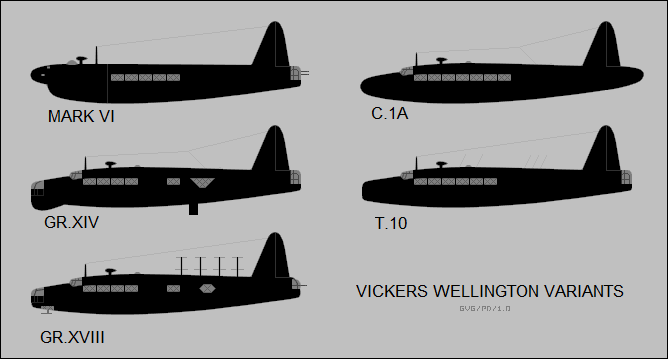
* The "Wellington Mark VII" was a single prototype, fitted with Merlin XX engines; it did not proceed to production. Following the Mark VII was the "Wellington General Reconnaissance (GR) Mark VIII", a maritime patrol aircraft based on the B.IC with Pegasus XVIII engines, and produced in three subvariants:
That gave a total of 394 GR.VIIIs, all built at Weybridge. The GR.VIII was followed by improved maritime patrol variants:
* The Wellington was a sturdy aircraft, and after Wellington bombers were withdrawn from Bomber Command operations, they generally had plenty of life left in them for other roles, such as transport and training:
One B.III was evaluated as a glider tug, but it doesn't appear that the Wellington was used operationally in that role. The Wellington didn't see much export service in any of its roles; they were operated by Commonwealth countries and Poles flying with the RAF, with some aircraft obtained by France and Greece after the war, their service being unclear.
* There were many special mission configurations of the Wellington. One of the most noteworthy were the Wellingtons modified to "Directional Wireless Installation (DWI)" configuration to sweep German magnetic mines; "DWI" was a meaningless cover designation for security purposes.
The first "Wellington DWI Mark I", a conversion of a Wellington Mk.IA, performed its initial flight in December 1939, going into operational service in January 1940. The turrets were removed and faired over, and an aluminum hoop was fitted around the aircraft, connected to the nose via a strut and running under the wings to be connected to the rear fuselage. A Ford vee-8 auto engine drove a generator to send alternating current through the hoop, producing a magnetic field. When the Wellington flew low over the water, the magnetic field would trip the mines. It is not clear how the hoop affected handling.
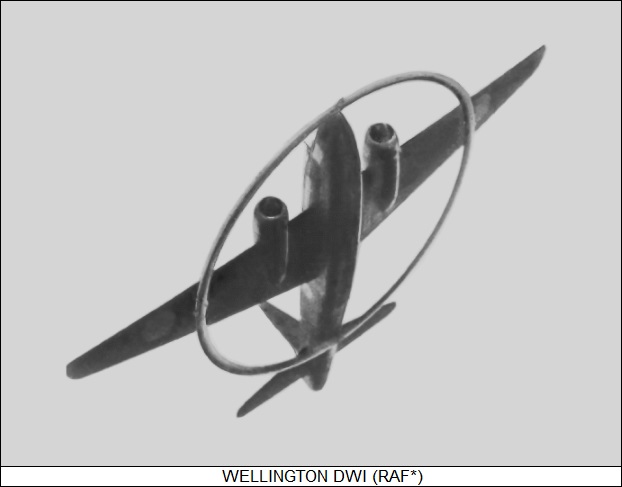
Three more DWI.I conversions were performed, the sweeps usually being performed by three aircraft to ensure good coverage. The right altitude was critical: too high and the mines wouldn't be tripped, too low and the aircraft might be caught up in the blast. The four DWI.I machines were later upgraded to "DWI.II" spec, the main change being fit of a more powerful de Havilland Gipsy VI engine to drive the generator. There were at least 11 further upgrades of Wellington bombers to DWI.II standard, the DWI machines being employed in the Middle East as well as in Britain.
Wellingtons were fitted with radio receivers from 1941 for the "ferret" or what would be later called the "electronic intelligence (ELINT)" role, locating and characterizing German radars and other "emitters". They were also used as electronic countermeasures platforms, to confuse adversary defenses; and were on occasion used for night photo-reconnaissance, carrying flares to illuminate targets. In addition, the Wellington was a popular engine testbed, being used to evaluate various piston engines, early Whittle jet engines -- mounted in the tail -- and in the postwar period, the Rolls-Royce Dart turboprop.
* The Wellington faded out of service in the early 1950s; some remain on static display, but none remain flying. A total of over 11,461 Wellingtons was built up to end of production, on 13 October 1945, making it the most heavily-produced British bomber of the war. Variants and production included:
It was the only one of the RAF's twin-engine bombers in production in 1939 that was manufactured all through the conflict -- the Bristol Blenheim, Handley-Page Hampden, and Armstrong-Whitworth Whitley all having become quickly obsolete in first-line combat. The Wellington never acquired the reputation of the Lancaster, and by the records it left behind, wasn't regarded as superlative. It was simply a sturdy, effective, and straightforward aircraft that put in a lot of work in a wide variety of roles.
BACK_TO_TOP* The Wellington had a "big brother" of sorts, the "Warwick". It had its roots in Air Ministry Specification "B.1/35" of 1935 for a "heavy" bomber -- by later standards, a large medium bomber. Although Handley-Page, Armstrong-Whitworth, and Vickers all submitted designs, the effort bogged down, with both Handley-Page and Armstrong-Whitworth deciding to work on other things, without flying prototypes. Vickers persisted with their "Type 284", which could be described as a Wellington with a fuselage and wing stretch, plus more powerful engines. There was substantial parts commonality between the two designs.
Technically speaking, the Type 284 design came first, and so the production Wellington was actually a cut-down Type 284; there were other differences, the Type 284 notably having a reprofiled tailfin. In any case, work on the Type 284 ultimately focused on two prototypes -- one to be powered by twin Rolls-Royce Vulture liquid-cooled 24-cylinder "X-configuration" engines, the other by twin 24-cylinder liquid-cooled Napier Sabre "H-configuration" engines.
The Vulture-powered B.1/35 prototype of the Warwick performed its initial flight on 13 August 1939, with Mutt Summers at the controls. It was an index of the level of frustration in the project that this was three years after the flight of the first Wellington prototype. The second B.1/35 prototype was delayed, partly because all Sabre engine production was needed for the Hawker Typhoon fighter, and so it was redesigned with twin Bristol Centaurus radial engines. At this point, the effort stumbled; Vultures were in short supply, they never would work very well anyway, so a Vulture-powered Warwick wasn't going to happen. The Centaurus was a much more robust powerplant, but availability was a problem there as well.
As a possible solution, the second prototype was refitted with US-made Pratt & Whitney Double Wasp R-2800-S14A4-G 14-cylinder two-row radial engines providing 1,380 kW (1,850 HP) each, performing its initial flight in this configuration in July 1941. The Double Wasp was not as suitable as the Centaurus, but it was available -- the French had ordered large quantities of them, with the lot falling into British hands after the fall of France to Germany in the spring of 1940 -- so the "Warwick Bomber Mark I" was ordered into production at the end of December 1940, powered by the Double Wasp.
The first production B.I wasn't delivered to the RAF for service tests until July 1942. The B.I featured three-bladed variable-pitch Hamilton Standard propellers; it had two-gun nose and dorsal turrets, plus a four-gun tail turret, all with 7.7-millimeter machine guns, and could haul 900 kilograms (2,000 pounds) of bombs. The prototypes had a two-gun tail turret, and the first had no dorsal turret.
By that time, the four-engine "heavies" were being delivered to the RAF in quantity, and there didn't seem to be any need for the Warwick as a bomber. Evaluation also revealed reliability issues with the Double Wasps, while the aircraft had some nasty handling problems. The big difficulty seems to have been a fundamental flaw in the notion of a "heavy twin", in that an engine out tended to mean loss of the aircraft. On top of that, there were yaw stability problems even with both engines turning. The problems were compounded by the "weight creep" the design underwent through development. There was talk of going to four engines, but analysis showed that the result would have limited range and bombload.
* Although 250 B.Is were ordered, only 16 Warwicks were built as bombers, and they ended up being mostly used for test and trials. It might have seemed logical to have just dumped the Warwick then and there, but the Warwick was saved by its compatibility with the Wellington, which made its manufacture relatively straightforward. In any case, the larger Warwick seemed suitable for the transport and air-sea rescue (ASR) roles.
A Warwick prototype was converted to a transport configuration, with 13 aircraft originally ordered as B.I bombers completed as "Warwick C Mark I" transports -- with a reinforced floor for hauling cargo; cabin windows; the turrets faired over; more fuel tankage; and engine exhaust flame dampers to allow them to keep a low profile in night flights. They were originally used by the British Overseas Airways Company (BOAC) for services to the Middle East, before reverting to RAF Transport Command in 1944.
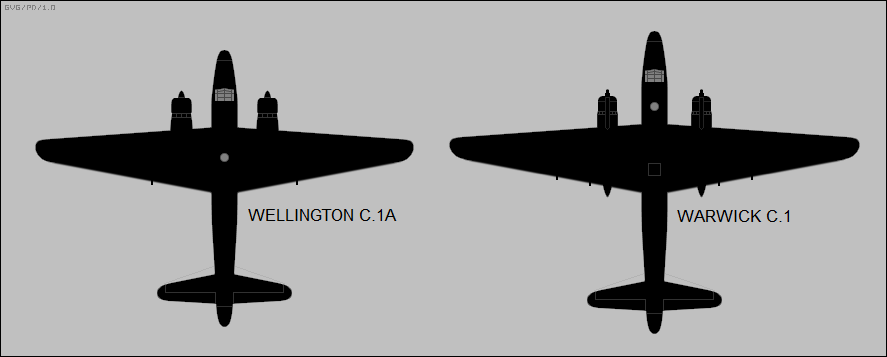
40 B.Is were converted in production to "Warwick ASR Mark I" configuration, retaining defensive armament, and hauling two airdropped Lindholme rescue kits, each with an inflatable raft and survival kit, entering service in August 1943. They were followed by production ASR.Is, in three "stages":
That gave a total of 40 + 10 + 20 + 205 == 275 ASR.Is. It is unclear if the earlier ASR.I machines were brought up to stage C specification.
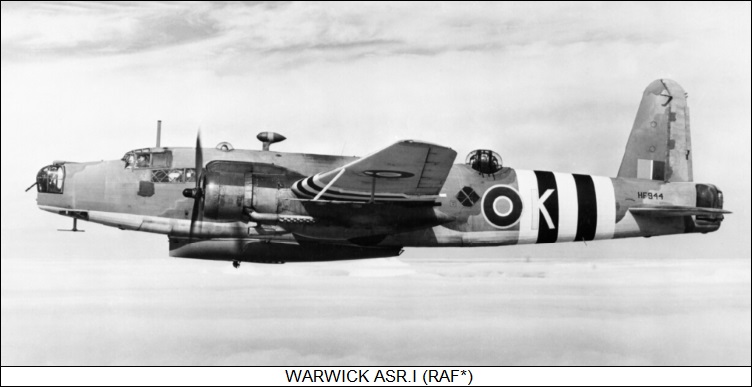
Centaurus engines did become available in quantity, leading to the "Warwick GR.II" for maritime patrol, powered by twin Centaurus VI engines providing 1,864 kW (2,500 HP) each. It had a single machine gun in the nose, a two-gun dorsal turret, and a four-gun tail turret, all with 7.7-millimeter guns. Normal bombload was 2,720 kilograms (6,000 pounds) of bombs, depth charges, or mines; a torpedo-bomber version was considered, but not built. 132 GR.IIs were produced, 14 of them being modified for weather reconnaissance and designated "Warwick GR.II.Met" -- though these 14 machines never saw squadron service.
___________________________________________________________________
VICKERS WARWICK GR.II:
___________________________________________________________________
wingspan:
29.49 meters (96 feet 9 inches)
wing area:
93.46 sq_meters (1,006 sq_feet)
length:
20.88 meters (68 feet 6 inches)
height:
5.64 meters (18 feet 6 inches)
empty weight:
14,120 kilograms (31,125 pounds)
MTO weight:
23,245 kilograms (51,250 pounds)
max speed at altitude:
420 KPH (260 MPH / 225 KT)
cruise speed:
340 KPH (210 MPH / 185 KT)
service ceiling:
5,790 meters (19,000 feet)
range:
4,910 kilometers (3,050 MI / 2,650 NMI)
___________________________________________________________________
The next production variant, the "Warwick C Mark III" transport, reverted to the Double Wasp. It was much like the Warwick C.I, but added a ventral cargo pannier -- trialed on an ASR.I -- plus a transparency under the nose for targeting paradrops. It could haul up to 24 equipped troops, though some Mark IIIs were fitted out for VIP service, with seats for 8 to 10 passengers. A hundred were built and served with RAF Transport Command.
There is mention of a "Warwick C Mark IV" with Centaurus engines, but it never flew. That meant the C.III was followed by the "Warwick GR Mark V", with:
It is puzzling that it took so long to add the fillet, that being a generally straightforward fix for yaw instability, but possibly it wasn't quite that simple. 210 GR.Vs were built, going into service with the South African Air Force as well as RAF Coastal Command from early 1945 -- but it appears that some number of them were simply put into storage and eventually scrapped.
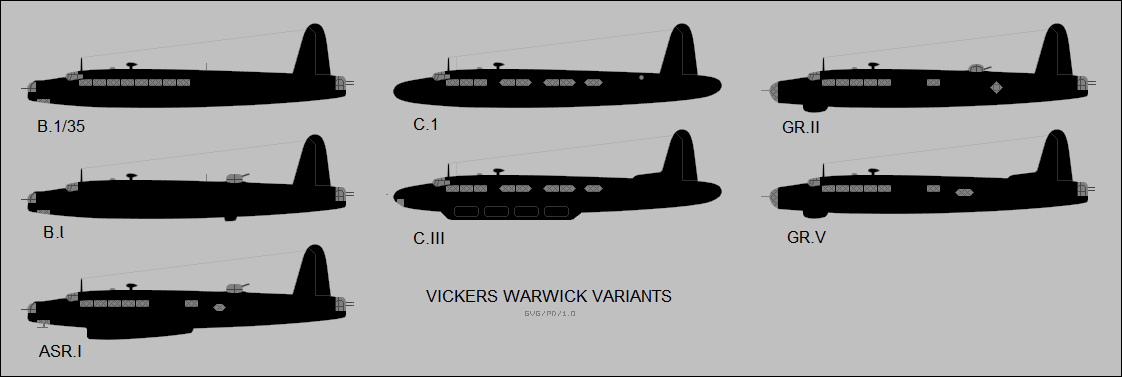
The final production variant was the "Warwick ASR Mark VI", much like the ASR.I, but with R-2800-2SBG Double Wasp engines. 95 were built; the RAF never used the ASR.VI designation, simply referring to these machines with the ASR.I designation. A total of 846 Warwicks was produced in all, all at Weybridge, the type lingering in the postwar era to 1947 -- some being used for engine trials -- and then effectively forgotten. It appears none have survived. The list below gives Warwick variants and production quantities:
* Even before the outbreak of war, Vickers had considered a commercial derivative of the Wellington. With the end of the war looming in 1944, British officials began to consider what aircraft manufacturers might do to stay in business once the shooting stopped. A committee under Lord Brabazon set up general specifications for a range of airliners, though none were expected to be available over the short term. As a near-term solution to handle the air traffic boom at the end of the war, the Air Ministry issued Specification 17/44 for a short-medium haul airliner. In consequence, Vickers obtained a contract to build three of what were originally named "Wellington Transport Aircraft" -- later being given the more inspiring name of "Viking".
The first of three Viking prototypes performed its initial flight on 22 June 1945, after the end of the war in Europe, but while the war against Japan was still in progress. It was powered by twin Bristol Hercules 130 radials with 1,250 kW (1,675 HP) each, Mutt Summers doing the honors. It crashed in April 1946, the crew surviving; the program continued, with 19 Vikings ordered for British European Airways (BEA).
These initial production "Viking 1A" machines had Wellington flight surfaces, still fabric-clad, but a new all-metal airliner fuselage; they had a crew of four, and a capacity of 21 passengers. They were powered by Bristol Hercules 630 engines with 1,260 kW (1,690 HP), driving four-bladed variable-pitch propellers. The Viking was unpressurized, with square windows and a single door on the left rear of the fuselage, just ahead of the tail, hinged to the front.
After a trial flight from Northolt to Oslo on 20 August 1946 by the newly formed BEA, the first regular Viking scheduled service commenced between Northolt and Copenhagen on 1 September 1946. BEA then obtained a batch of confusingly-designated "Viking 1" airliners, in which the fabric skinning of the flight surfaces was replaced with metal skinning; they were powered by Hercules 634 engines featuring technical improvements, but no uprating. Some Viking 1A airliners were upgraded to Viking 1 standard. A total of 29 Viking 1s was built, with 12 going to the RAF under the designation of "Viking C.2" -- four of these being committed to the King's Flight, which provided transport support for Britain's royal family.

The Viking 1 was followed the "Viking 1B", initial flight being in August 1946. The Viking 1B featured a short fuselage stretch of 71 centimeters (28 inches), from 19.15 meters (62 feet 10 inches) to 19.86 meters (65 feet 2 inches), raising passenger capacity to 24. A total of 113 Viking 1Bs was built, BEA being the biggest single customer, but they were also sold to a number of airlines and foreign military services. The last Viking was rolled out at the end of late 1947, with 164 built in all.
___________________________________________________________________
VICKERS VIKING 1B:
___________________________________________________________________
wingspan:
27.2 meters (89 feet 3 inches)
wing area:
82 sq_meters (882 sq_feet)
length:
19.86 meters (65 feet 2 inches)
height:
5.97 meters (19 feet 7 inches)
empty weight:
10,430 kilograms (23,000 pounds)
MTO weight:
15,420 kilograms (34,000 pounds)
max speed at altitude:
425 KPH (265 MPH / 230 KT)
cruise speed:
340 KPH (210 MPH / 185 KT)
service ceiling:
7,600 meters (25,000 feet)
range:
2,740 kilometers (1,700 MI / 1,480 NMI)
___________________________________________________________________
One Viking 1B was fitted on the production line with Nene I turbojets, providing 22.3 kN (2,265 kgp / 5,000 lbf) thrust each, as the "Nene Viking". It performed its initial flight 6 April 1946, Summers once again being the pilot. Maximum speed was over 750 KPH (465 MPH). The Nene Viking flew from London to Paris with a full passenger load on 25 July 1948, making the trip in 34 minutes 7 seconds -- twice as fast as a piston-powered Viking, faster than the previous record set by a Supermarine Spitfire. No production Nene Vikings were built, the demonstrator being refitted with Hercules radials and going into commercial service as a Viking 1B.
From 1951, the surviving BEA Vikings were modified with 36 passenger seats and named the "Admiral Class", being used for low-cost shuttle routes. BEA operated the Viking until late 1954, when the last was displaced by the more modern, pressurized Airspeed Ambassador and Vickers Viscount. Most of the BEA Vikings were sold off to independent airlines, the type remaining in commercial service into the 1960s. One ex-BEA Viking 1B was kitted up as a VIP aircraft for the Arab League, being mostly used by the King of Jordan.
* A Viking 1B, the 158th Viking built, became the prototype of the military "Valletta", named after the Maltese city, this machine performing its initial flight on 30 June 1947, with Mutt Summers at the controls. The Valleta featured more powerful Hercules 230 radials with 1,475 kW (1,975 HP) each; a double cargo door, with an inset passenger door, on the left rear side of the fuselage; a reinforced floor; and longer-stroke landing gear. 211 were delivered to the RAF as "Valletta C.1" utility transports, capable of carrying 34 equipped troops, 20 paratroops, or cargo.
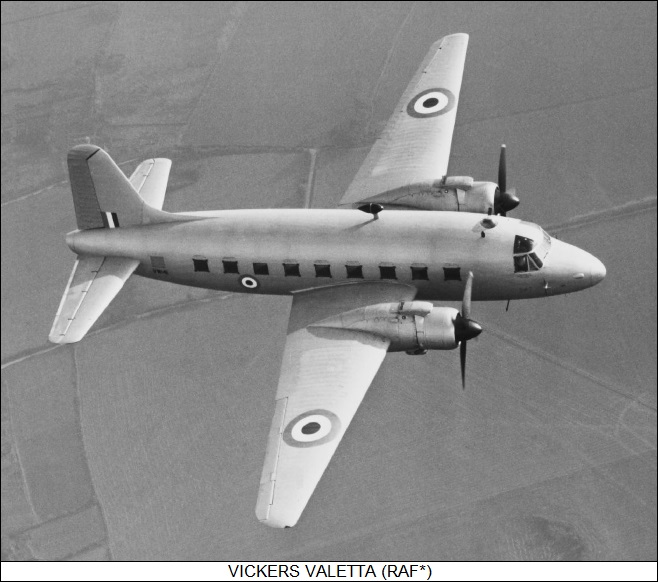
11 "Valleta C.2" VIP transports were built as well, with additional fuel tanks and seating for 9 to 15 passengers; along with 40 "Valletta T.3" navigation trainers, featuring a row of astrodomes along the top of the aircraft. 262 Valletas were built up to end of production in 1951. 18 Valleta T.3s were converted to "T.4" spec, with an extended nose housing an "airborne intercept" radar system. Vallettas saw combat service in Malaya, Aden, and in the 1956 Suez operation.
Following the end of production of the Valletta, Vickers then built a crew trainer variant, the "Varsity T.1", as per Air Ministry Specification T.13/48, the initial prototype performing its first flight on 17 July 1949. The Varsity was a major redesign, with tricycle landing gear; wider wingspan; a longer fuselage, with a longer nose, stretching length again by 71 centimeters (28 inches) to 20.57 meters (67 feet 6 inches); a ventral pannier for a bombardier and practice bombs; and Hercules 264 engines with 1,455 kW (1,950 HP) each. The maximum number of people carried was up to 11, though it was generally less than that, the number depending on the specific training requirement.
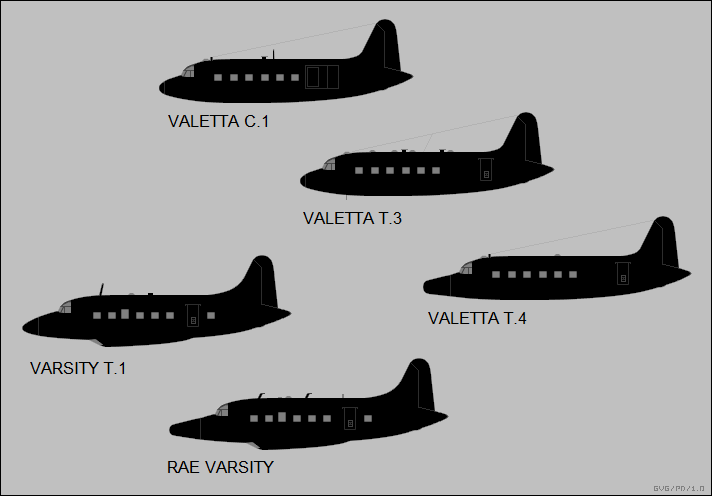
163 Varsities were built into 1954, including one kitted up from spares, all going into RAF service -- except one that went to Sweden, being used in the ELINT role and trials, being designated "Tp 82". It appears that some RAF Varsities were also used for signals intelligence, operationally or in training; a few were used for radar calibration, and as trials machines. The Varsity was finally withdrawn from RAF service in May 1976, being replaced in the pilot and navigation training roles by the Scottish Aviation Jetstream T1. One example continued to be flown through the next decade by the Royal Aircraft Establishment (RAE), this machine being used for trials.
A number of Vikings / Vallettas and Varsities survive as static displays, but sadly, none remain flightworthy. 164 Vikings, 262 Valettas, and 163 Varsities were built, for total production of 589 aircraft. The list below gives variants and quantities:
* As a footnote to the story ... notions for a four-engine, pressurized version of the Warwick, leveraging off the Wellington Mark V/VI, led to the Vickers "Windsor" experimental bomber, which was developed in response to Air Ministry Specification B.5/41, later modified to specification B.3/42. The design team was led by Barnes Wallis and Rex Pierson. The first prototype, the "Type 447", flew in 23 October 1943, being powered by four Rolls-Royce Merlin 65 engines with 980 kW (1,315 HP) each.
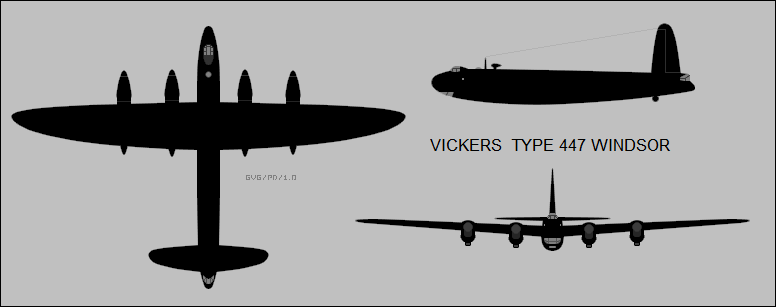
The Type 447 Windsor had the geodetic construction of the Wellesley, Wellington, and Warwick, with a skinning of a steel wire mesh-based composite material. It had taildragger landing gear; unusually, there were four main gear, one in each engine nacelle, all with single wheels. The Type 447 had a wingspan of 35.71 meters (117 feet 2 inches), a length of 23.43 meters (76 feet 10 inches), and an empty weight of 17,750 kilograms (28,605 pounds). Top speed was about 510 KPH (315 MPH / 275 KT), with a ceiling of 8,300 meters (27,250 feet).
The Type 447 was written off due to a bad landing after only 34 hours of flight; one of the props had jammed, the pilot was not familiar with the type, and the aircraft broke its back on touchdown. The second prototype, the "Type 557", performed its first flight on 15 February 1944; it featured Merlin 85 engines with 1,220 kW (1,635 HP) each, and was fitted with armor plus some other operational kit. The third prototype, the "Type 480", performed its initial flight on 11 July 1944; it was similar to the second, but was used to test defensive armament -- consisting of dual 20-millimeter cannon in a barbette at the rear of each outboard engine nacelle, remotely aimed by a gunner in the tail. This cannon fit was evaluated in a Warwick ASR.I.
Apparently a production machine was to have nose guns and beam guns as well, though it seems a range of configurations were considered. Projected bombload for the operational version was 5,500 kilograms (12,120 pounds), with a range of over 4,650 kilometers (2,900 miles / 2,510 NMI). A fourth machine was being assembled when the program was cancelled in November 1945.
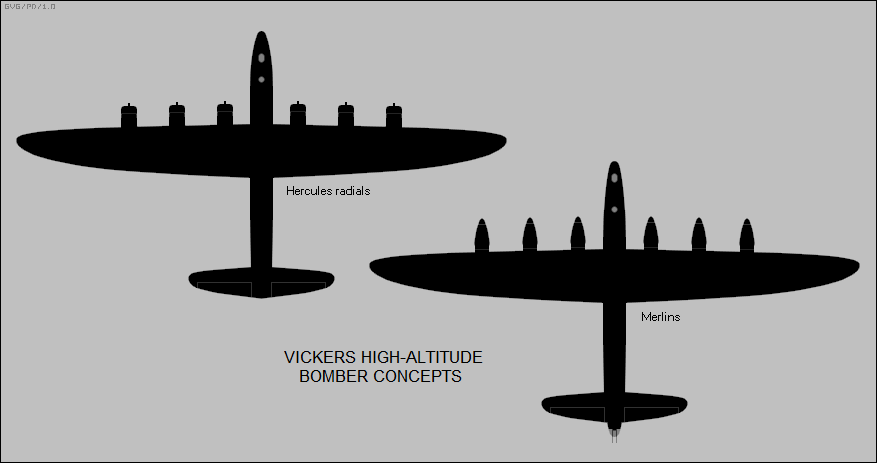
All of the Windsors were scrapped. Concepts were floated in early 1945 for a Windsor with four Clyde turboprops, driving contra-rotating props, but it didn't happen. Vickers also played with a number of six-engine "high altitude bomber" concepts during the war in a wide range of configurations, including canards and flying wings, with a few of them in the form of long-range / high-altitude bombers along the lines of the Windsor, but with six Merlins or six Hercules radials. None of them ever amounted to more than interesting paper projects.
* Sources include:
I couldn't find much documentation on the Vickers Viking, so the data here is mostly derived from the online Wikipedia.
* Revision history:
v1.0.0 / 01 oct 15 v1.0.1 / 01 sep 17 / Review & polish. v1.0.2 / 01 aug 19 / Review & polish. v1.0.3 / 01 jun 21 / Review & polish. v1.0.4 / 01 may 23 / Review & polish. v1.0.5 / 01 may 25 / Review & polish. (+)BACK_TO_TOP
